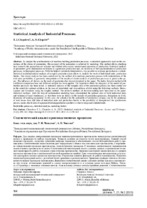Statistical Analysis of Industrial Processes

Date
2022Publisher
Another Title
Статистический анализ производственных процессов
Bibliographic entry
Chepeleva, T. I. Statistical Analysis of Industrial Processes = Статистический анализ производственных процессов / T. I. Chepeleva, A. N. Chepelev // Наука и техника. – 2022. – № 2. – С. 158-163.
Abstract
To analyze the synchronization of machine-building production processes, a statistical approach is used on the correctness of the choice of parameters. The accuracy of the parameters is achieved by modeling. This method allows checking how correctly the parameters are selected and whether they ensure uninterrupted operation of production. Statistical analysis of parameters gives information on failures in a particular production unit, on violations of the synchronization of production processes, technological processes. With the help of statistical characteristics, it is possible to evaluate production as a whole. Statistical multidimensional analysis of complex production data allows to analyze the work of individual units, production blocks. The cluster analysis has been carried out by the method of K-medium production process with minimization of the total error probability. A geometric interpretation of the results of cluster analysis of production processes is given in the paper. The influence of factors on the work of production has been determined in the paper. The index factorial method with a different comparison base and different weights has been applied. The hypothesis about the adequacy of the model of production processes has been tested. A statistical analysis of the complex data of the production process has been carried out in the search for optimal solutions in the case of uncertainty and in conditions of risk using the following methods: Bayes, Laplace and Germeyer using the simplex method. The network methods of decision-making have been used in the paper. Statistical methods with the help of mathematical modeling have substantiated the optimal sizes of both individual parts and volumes of local warehouses, so that there were no delays in the transfer of production processes, disruptions in work, downtime of working equipment. In this case, the criterion for the optimality of production volumes can be the minimum of total losses from idle time of individual units and production blocks to the possibility of disruption of the synchronous process modes due to lack of equipment (arising production pockets) or due to long-used outdated units.
Abstract in another language
Для анализа синхронизации процессов машиностроительного производства используется статистический подход о правильности выбора параметров. Точность величин достигается путем моделирования. Данный способ позволяет проверить, насколько правильно выбраны параметры и обеспечивают ли они бесперебойную работу производства. Статистический анализ величин дает информацию о сбоях в том или ином узле производства, о нарушениях синхронизации процессов производства, технологических процессов. С помощью статистических характеристик можно оценить производство в целом. Статистический многомерный анализ сложных данных о производстве позволяет анализировать работу отдельных узлов и блоков производства. Проведен кластерный анализ методом K-средних процессов производства с минимизацией полной вероятности ошибки. Дана геометрическая интерпретация результатов кластерного анализа процессов производства. Определено влияние факторов на работу производства. Применен индексный факторный метод с различной базой сравнения и разными весами. Проведена проверка гипотезы об адекватности модели процессов производства. Выполнен статистический анализ сложных данных процесса производства при поиске оптимальных решений в случае неопределенности и в условиях риска методами Байеса, Лапласа и Гермейера с помощью симплекс-метода. Использованы сетевые методы принятия решений. Статистическими методами посредством математического моделирования провели обоснование оптимальных размеров как отдельных деталей, так и объемов местных складов, чтобы не было опозданий в работе передачи процессов производства, срывов в работе, простоев оборудования. В этом случае критерием оптимальности объемов производства может служить минимум суммарных потерь от простоя отдельных узлов и блоков производства до возможности нарушения режимов синхронного процесса из-за нехватки оборудования (возникших карманов производства) или из-за давно используемых устаревших агрегатов.
View/
Collections
- № 2[10]
